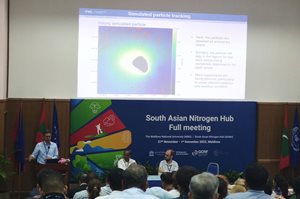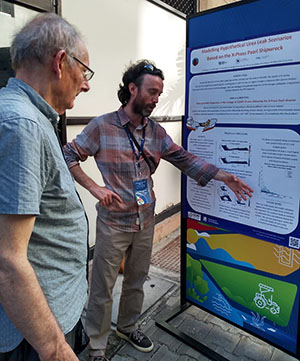Story
PML scientists contribute to tackling the nitrogen pollution challenge
6 December 2022
Last week three PML scientists attended the annual meeting of the UKRI GCRF South Asian Nitrogen Hub at the Maldives National University, to present their latest research on the global challenge of nitrogen pollution.

Thoddoo, Maldives. Ahmed Zeehan | Unsplash
Through waste water management, evolving agricultural practices over the decades and other activities, humans have significantly altered the nitrogen flows on Earth. As much as this has benefitted food production and eased waste issues on land among other benefits, rises in nitrogen in the Earth system over the years has had unanticipated negative impacts on the wider environment and human health. Nitrogen pollution is now recognised as one of the four planetary boundaries that we have now exceeded, alongside climate change, deforestation and biodiversity loss.
There are few places on Earth more affected than South Asia, with levels of nitrogen pollution rapidly increasing and as such, the internationally-collaborative UKRI GCRF South Asian Nitrogen Hub was set up to help to tackle the cross-border nitrogen challenge. The Hub brings together world-leading scientists from over 30 research organisations across South Asia and the UK and aims to improve nitrogen management and measure how nitrogen is impacting our environment.
The PML team presented their research to over 140 delegates including scientists from UK, India, Afghanistan, Pakistan, Sri Lanka, Bangladesh and Maldives as well as the Vice President of the Maldives, the Director General of the South Asia Co-operative Environment Programme (SACEP), the Vice Chancellor of the Maldives National University and officers from other governmental agencies in Asia.
 Dr Muchamad Al Azhar, Ocean Modeller at PML, summarised his team’s preliminary research that shows that pollution emitted inside the Thoddoo lagoon or harbour could remain for few days before being washed out in the ocean. This means that the wastewater treatment that has been planned and is awaiting approval will need to be carefully managed to minimise any potential further impacts to the delicate ecosystem of the lagoon.
Dr Muchamad Al Azhar, Ocean Modeller at PML, summarised his team’s preliminary research that shows that pollution emitted inside the Thoddoo lagoon or harbour could remain for few days before being washed out in the ocean. This means that the wastewater treatment that has been planned and is awaiting approval will need to be carefully managed to minimise any potential further impacts to the delicate ecosystem of the lagoon.The next step of this research is to build the first integrated nitrogen budget for the region then work with colleague at the Maldives National University, the local councils and the Maldivian government to provide comprehensive analysis of different scenarios of nitrogen
 management in these rapidly developing islands. Dr Olivia Rendon is currently visiting few of these islands (Thoddoo, Dhigurah and Vilingili) to study how local people trade-off between the conservation of marine ecosystems and the economic benefits of activities, such as agriculture and tourism.
management in these rapidly developing islands. Dr Olivia Rendon is currently visiting few of these islands (Thoddoo, Dhigurah and Vilingili) to study how local people trade-off between the conservation of marine ecosystems and the economic benefits of activities, such as agriculture and tourism.The global nitrogen budget has been increasing rapidly due to agriculture, waste, energy production, industrial activities and traffic, and South Asia has a critical role to play in managing this budget. Its population of approximately 1.7 billion is increasing at 1.7% annually and is expected to have doubled by around 2050. Fertiliser inputs have also been projected to double, giving South Asia the highest nitrogen inputs in the world by 2050, although conversely, food produced per nitrogen input has halved since 1990. Given the impact nitrogen could have on populations in South Asia, the region is at the forefront of tackling the issue, with several international initiative, including the Colombo declaration.
 Dr Yuri Artioli, Marine Ecosystem Modeller, PML’s lead scientist on the project and co-lead of the work package on assessing impacts of nitrogen pollution on aquatic ecosystems and human health, says: “It is an honour to support with our research the great effort of the South Asian countries to lead in the international management of nitrogen pollution. Meeting with local people, government officials as well as fellow scientists from these countries allowed us to see directly how the research conducted at PML could provide benefit to these communities and gave us further motivation for our work”.
Dr Yuri Artioli, Marine Ecosystem Modeller, PML’s lead scientist on the project and co-lead of the work package on assessing impacts of nitrogen pollution on aquatic ecosystems and human health, says: “It is an honour to support with our research the great effort of the South Asian countries to lead in the international management of nitrogen pollution. Meeting with local people, government officials as well as fellow scientists from these countries allowed us to see directly how the research conducted at PML could provide benefit to these communities and gave us further motivation for our work”.